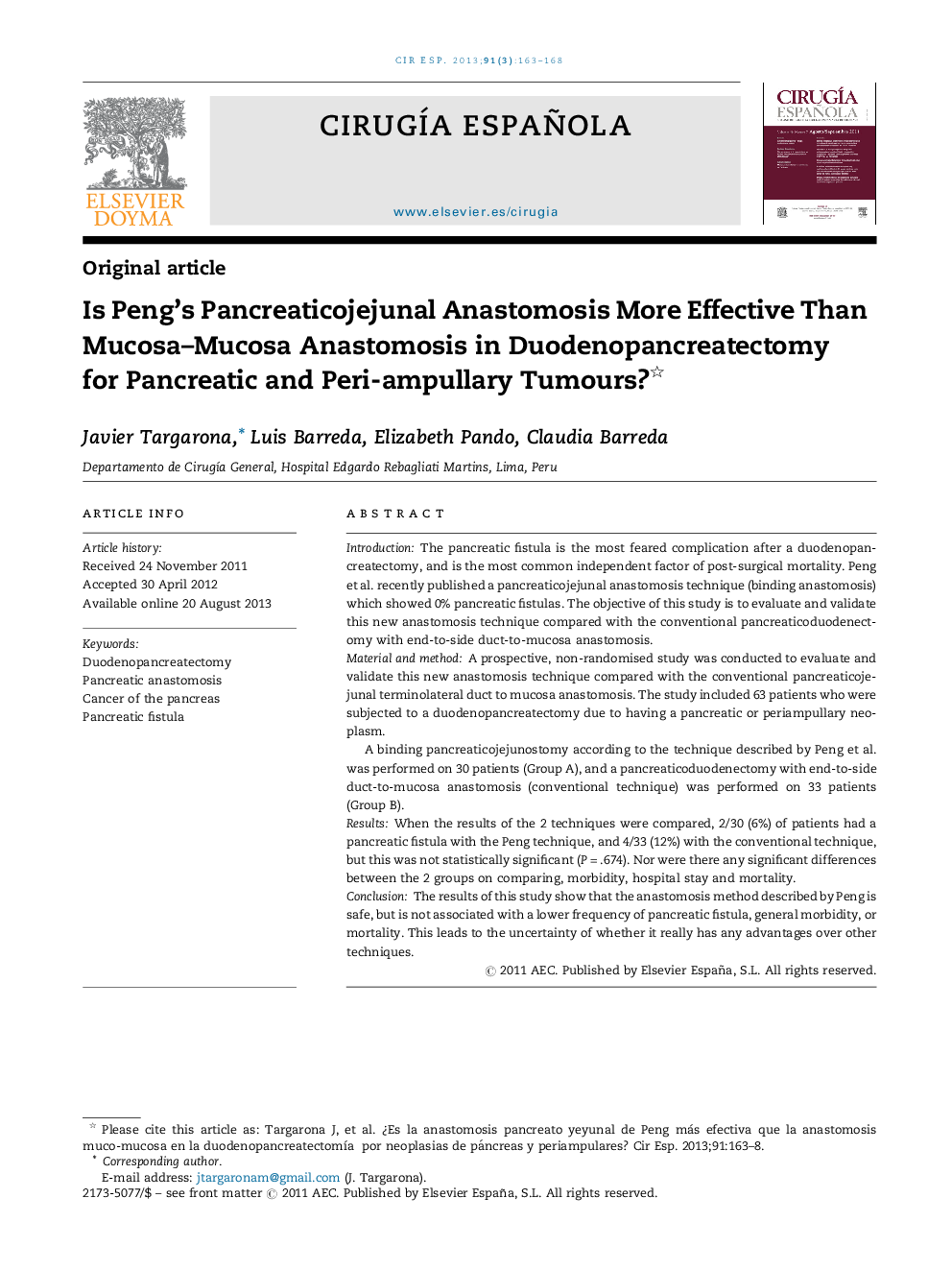| کد مقاله | کد نشریه | سال انتشار | مقاله انگلیسی | نسخه تمام متن |
|---|---|---|---|---|
| 4255521 | 1284457 | 2013 | 6 صفحه PDF | دانلود رایگان |

IntroductionThe pancreatic fistula is the most feared complication after a duodenopancreatectomy, and is the most common independent factor of post-surgical mortality. Peng et al. recently published a pancreaticojejunal anastomosis technique (binding anastomosis) which showed 0% pancreatic fistulas. The objective of this study is to evaluate and validate this new anastomosis technique compared with the conventional pancreaticoduodenectomy with end-to-side duct-to-mucosa anastomosis.Material and methodA prospective, non-randomised study was conducted to evaluate and validate this new anastomosis technique compared with the conventional pancreaticojejunal terminolateral duct to mucosa anastomosis. The study included 63 patients who were subjected to a duodenopancreatectomy due to having a pancreatic or periampullary neoplasm.A binding pancreaticojejunostomy according to the technique described by Peng et al. was performed on 30 patients (Group A), and a pancreaticoduodenectomy with end-to-side duct-to-mucosa anastomosis (conventional technique) was performed on 33 patients (Group B).ResultsWhen the results of the 2 techniques were compared, 2/30 (6%) of patients had a pancreatic fistula with the Peng technique, and 4/33 (12%) with the conventional technique, but this was not statistically significant (P = .674). Nor were there any significant differences between the 2 groups on comparing, morbidity, hospital stay and mortality.ConclusionThe results of this study show that the anastomosis method described by Peng is safe, but is not associated with a lower frequency of pancreatic fistula, general morbidity, or mortality. This leads to the uncertainty of whether it really has any advantages over other techniques.
ResumenIntroducciónLa fístula pancreática es la complicación más temida luego de una duodenopancreatectomía, siendo el factor independiente de mortalidad postoperatoria más frecuente. Recientemente Peng et al. publicaron una técnica de anastomosis pancreato yeyunal «anastomosis por atadura» (binding anastomosis) que presentaba 0% de fístula pancreática. El objetivo de este estudio es evaluar y validar esta nueva técnica de anastomosis comparada con la anastomosis pancreato yeyunal termino-lateral ducto mucosa convencional (PYTL-C).Material y metodoSe efectuó un estudio prospectivo no aleatorizado para evaluar y validar esta nueva técnica de anastomosis comparada con la anastomosis pancreato yeyunal termino-lateral convencional. Se incluyó a 63 pacientes a quienes se les realizó una duodenopancreatectomía por presentar una neoplasia pancreática o periampular, intervenidos por un mismo cirujano.A 30 pacientes (Grupo A) se les realizó una anastomosis termino-terminal según la técnica descrita por Peng, y a 33 pacientes (Grupo B) se les realizó una anastomosis termino-lateral mucosa-mucosa (técnica convencional).ResultadosCuando se compararon las 2 técnicas, la fístula pancreática se presentó en 2/30 pacientes (6,6%) con anastomosis de Peng y en 4/33 pacientes (12%) con anastomosis mucosa-mucosa, sin embargo esto no fue significativo (p = 0,674). Además cuando se comparó la morbilidad, estancia hospitalaria y mortalidad tampoco existió diferencia significativa entre los 2 grupos.ConclusiónLos resultados de este estudio muestran que la anastomosis descrita por Peng es un método seguro, pero que no está asociada a una menor frecuencia de fístula pancreática, morbilidad general, ni mortalidad, por lo cual se puede poner en duda si realmente presenta una ventaja sobre otras técnicas.
Journal: Cirugía Española (English Edition) - Volume 91, Issue 3, March 2013, Pages 163–168